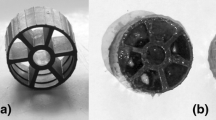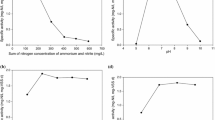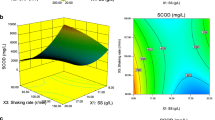Abstract
The influence of the operational variables on the Anammox process has been generally researched considering each variable separately. However, the optimization of the process also requires the identification of the more significant variables and their possible interactions. Response surface models were successfully applied to evaluate the performance of the Anammox process in a deammonification system (i.e., one-stage biofilm Anammox process) taking into account the combined effects caused by two sets of three variables. Specific Anammox activity was measured by a manometric method and used as the response variable. The obtained models pointed out that the significant variables were the temperature, the value of pH, and the ratio between the unionized species of the substrates (free ammonia and free nitrous acid (FA/FNA)). There were interactions among them caused by chemical equilibriums. Total nitrogen concentration and ammonium concentration were found to be not significant in the tested range. According to the models, the optimum values of temperature, pH, and free ammonia to free nitrous acid ratio within the test ranges were, respectively, 30°C, 7.0, and 0.3. Further research at higher temperatures and lower values of pH and FA/FNA ratios would be necessary in order to find the absolute optimum conditions for the process. The obtained model can be also useful in order to develop control strategies that take into account the significant variables and their optimum ranges. A strategy to control deammonification reactors has been proposed, according to the results of the modeling.






Similar content being viewed by others
References
Ahn, Y. H., Hwang, I. S., & Min, K. S. (2004). Anammox and partial denitritification in anaerobic nitrogen removal from piggery waste. Water Science and Technology, 49(5–6), 145–153.
Anthonisen, A. C., Loehr, R. C., Prakasam, T. B. S., & Srinath, E. G. (1976). Inhibition of nitrification by ammonia and nitrous acid. Journal of Water Pollution Control Federation, 48(5), 835–852.
Bator, E. (2006). Research on optimization fo CANON process using MODDE software. Master Thesis, Land and Resources Engineering Department, Royal Institute of Tecknology, Stockholm, Sweden.
Box, G. E. P., & Wilson, K. B. (1951). On the experimental attainment of optimum conditions (with discussion). Journal of the Royal Statistical Society, Series B, 13(1), 1–45.
Box, G. E. P., & Behnken, D. (1960). Some new three level designs for the study of quantitative variables. Technometrics, 2, 455–475.
Cema, G., Wiszniowski, J., Żabczyński, S., Zabłocka-Godlewska, E., Raszka, A., & Surmacz-Górska, J. (2007). Biological nitrogen removal from landfill leachate by deammonification assisted by heterotrophic denitrification in a rotating biological contactor (RBC). Water Science and Technology, 55(8–9), 35–42.
Chang, C.-Y., Lee, C.-L., & Pan, T.-M. (2006). Statistical optimization of medium components for the production of Antrodia cinnamomea AC0623 in submerged cultures. Applied Microbiology and Biotechnology, 72, 654–661.
Dapena-Mora, A., Campos, J. L., Mosquera-Corral, A., Jetten, M. S. M., & Méndez, R. (2004). Stability of the ANAMMOX process in a gas-lift reactor and a SBR. Journal of Biotechnology, 110(2), 159–170.
Dapena-Mora, A., Fernández, I., Campos, J. L., Mosquera-Corral, A., Méndez, R., & Jetten, M. S. M. (2007). Evaluation of activity and inhibition effects on Anammox process by batch tests based on the nitrogen gas production. Enzyme and Microbial Technology, 40(4), 859–865.
Dosta, J., Fernández, I., Vázquez-Padín, J. R., Mosquera-Corral, A., Campos, J. L., Mata-Álvarez, J., et al. (2008). Short- and long-term effects of temperature on the Anammox process. Journal of Hazardous Materials, 154(1–3), 688–693.
Egli, K., Fanger, U., Alvarez, P. J. J., Siegrist, H., van der Meer, J., & Zehnder, A. J. B. (2001). Enrichment and characterization of an anammox bacterium from a rotating biological contactor treating ammonium-rich leachate. Archives of Microbiology, 175, 198–207.
Eriksson, L., Johansson, E., Kettanch-Wold, N., & Wold, S. (2001). Multi and megavariate data analysis: Principles and applications. Umeå, Sweden: Umetrics AB.
Fernández, I., Dosta, J., Campos, J. L., Mosquera-Corral, A., Méndez, R. (2008). Short- and long-term effects of ammonia and nitrite on the Anammox process. In Proc. of the Third International Meeting on Environmental Biotechnology and Engineering. P. Mallorca, Spain, 21-25 September.
Fux, C., Boehler, M., Huber, P., Brunner, I., & Siegrist, H. (2002). Biological treatment of ammonium-rich wastewater by partial nitritation and subsequent anaerobic ammonium oxidation (anammox) in a pilot plant. Journal of Biotechnology, 99, 295–306.
Fux, C., Marchesi, V., Brunner, I., & Siegrist, H. (2004). Anaerobic ammonium oxidation of ammonium-rich waste streams in fixed-bed reactors. Water Science and Technology, 49(11–12), 77–82.
Gut, L., Plaza, E., & Hultman, B. (2007). Assessment of a two-step partial nitritation/Anammox system with implementation of multivariate data analysis. Chemometrics and Intelligent Laboratory Systems, 86, 26–34.
Grubbs, F. E. (1969). Procedures for detecting outlying observations in samples. Technometrics, 11, 1–21.
Isaka, K., Sumino, T., & Tsuneda, S. (2007). High nitrogen removal performance at moderately low temperature utilizing anaerobic ammonium oxidation reactions. Journal of Bioscience and Bioengineering, 103(5), 486–490.
Jetten, M. S. M., Horn, S. J., & van Loosdrecht, M. C. M. (1997). Towards a more sustainable municipal wastewater treatment system. Water Science and Technology, 35(9), 171–180.
Jung, J. Y., Kang, S. H., Chung, Y. C., & Ahn, D. H. (2007). Factors affecting the activity of anammox bacteria during start up in the continuous culture reactor. Water Science and Technology, 55(1/2), 459–468.
Karamanev, D. G., & Nikolov, L. (1988). Influence of some physicochemical parameters on bacterial activity of biofilm: ferrous iron oxidation by Thiobacillus ferrooxidans. Biotechnology and Bioengineering, 31, 295–299.
NIST/SEMATECH. (2010). E-handbook of statistical methods, http://www.itl.nist.gov/div898/handbook/, retrieved on 30th April 2010.
Olem, H., & Unz, R. F. (1980). Rotating-disc biological treatment of acid mine drainage. Journal of Water Pollution Control Federation, 52, 257–269.
Rysgaard, S., Glud, R. N., Risgaard-Petersen, N., & Dalsgaard, T. (2004). Denitrification and anammox activity in arctic marine sediments. Limnology and Oceanography, 49(5), 1493–1502.
Seth, M., & Chand, S. (2000). Biosynthesis of tannase and hydrolysis of tannins to gallic acid by Aspergillus awamori—optimisation of process parameters. Process Biochemistry, 36, 39–44.
Strous, M. (2000). Microbiology of anaerobic ammonium oxidation. PhD Thesis. TU Delft. The Netherlands.
Strous, M., Kuenen, J. G., & Jetten, M. S. M. (1999). Key physiology of anaerobic ammonium oxidation. Applied and Environmental Microbiology, 65(7), 3248–3250.
Szatkowska, B., & Plaza, E. (2006). Temperature as a factor influencing the Anammox process performance. Waster and Environmental Management Series No 12, Young Researchers 2006 (pp. 51–58). London, UK: IWA Publishing.
Szatkowska, B., Cema, G., Plaza, E., Trela, J., & Hultman, B. (2007). A one-stage system with partial nitritation and Anammox processes in the moving-bed biofilm reactor. Water Science and Technology, 55(8), 19–26.
Toh, S. K., Webb, R. I., & Ashbolt, N. J. (2002). Enrichment of autotrophic anaerobic ammonium oxidizing consortia from various wastewaters. Microbial Ecology, 43, 154–167.
Yang, Y., Zuo, J. E., Shen, P., & Gu, X. S. (2006). Influence of temperature, pH value and organic substance on activity of ANAMMOX sludge. Huan Jing Ke Xue, 27(4), 691–695. in Chinese.
Acknowledgements
I. Fernández thanks Xunta de Galicia for the María Barbeito grant and for the travel grant to research in Sweden, partially funded by EU ESF. Support was given by Hammarby Sjöstadsverk and KTH. Help from Monica Löwén, Jinjing Yang, Andriy Malovanyy, and Tomasz Stypka is sincerely appreciated.
Author information
Authors and Affiliations
Corresponding author
Rights and permissions
About this article
Cite this article
Fernández, I., Plaza, E., Trela, J. et al. Evaluation of Deammonification Process by Response Surface Models. Water Air Soil Pollut 215, 299–309 (2011). https://doi.org/10.1007/s11270-010-0479-9
Received:
Accepted:
Published:
Issue Date:
DOI: https://doi.org/10.1007/s11270-010-0479-9




